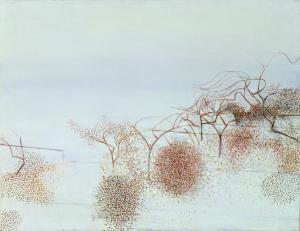
I was born in Chiswick and lived in Bedford Park and then Grove Park, until my family moved to Kingston when I was thirteen. I was always fascinated by the River Thames, with its tides and many changing moods. I had a paper round which used to encompass a downbeat marina called Chiswick Quay, connected to the River Thames by an old lock. The marina, which was located just off Hartington Road near Chiswick Bridge, contained many run down house boats. It was originally a lake and was formally part of Lord Burlington’s Chiswick House Estate. It has since been redeveloped with upmarket housing and the house boats have made way for shiny plastic motor yachts. I miss walking by the Thames and smelling the hops from the brewing of Fullers beer from the Griffin Chiswick riverside brewery. Whenever I go back I wonder at how Chiswick has changed since I left some forty five years ago.
Victor Pasmore also lived in Chiswick, from 1942 until 1947. He first lived in a house at Chiswick Mall, moving a short way along the river to 16 Hammersmith Terrace.

This is a fine and remarkably original terrace of seventeen beautiful Georgian houses which directly face the Thames. The houses were built in around 1770 and have over the years had many previous famous occupants prior to Pasmore’s arrival. In fact it was considered a hot spot by eminent members of the London Arts & Crafts movement in its day. Practically every house was inhabited by an artist or writer of some sort and they would apparently congregate around the post box for a catch up over the last post.

One of the most notable residents was Sir Emery Walker, who lived at no 3 and then number 7. Emery was a great printer and antiquary during the Arts and Crafts period, who assisted his good friend, William Morris (who incidentally lived just down the road at Kelmscott House – now home of the William Morris Society) in setting up the Kelmscott Press. He also helped to run the Doves Press, which was run from number 1 for several years. Morris’s daughter, May, lived next door to Sir Emery, at number 8, and her friend, the painter Mary Anne Sloane, took up residency there after she moved out.
Back to our more recent illustrious inhabitant, I have always wanted a ‘Chiswick’ Pasmore. His style at the time was a sober form of Cezannesque realism in both portraits and landscape. The time he spent at 16 Hammersmith Terrace was very productive. The Tate have two works which are views of the Thames from the garden of his house. ‘The Hanging Gardens of Hammersmith No.1’ and ‘The Gardens of Hammersmith No.2’

At this time Pasmore had a very encouraging and enthusiastic patron called Kenneth Clark. He purchased a painting from Pasmore called ‘A Winter Morning’ 1944 which was a view from his garden. This picture appears in the small 1945 Penguin Modern Painters book on the artist with an introduction from Clive Bell. This small exquisite book is a must for all Pasmore fans.

A similar painting also appears in the 1980 Catalogue Raisonne, reproduced and titled ‘The Bird Gardens : Winter Morning’ 1944-46, which seems to share certain identical details. The explanation is that a couple of years after Clark bought the painting Victor borrowed it back and when it was returned, it transpired that he had reworked the picture, removing some of the more mundane details, adding some elements and, more fundamentally, turning the whole into a winter scene.

Although it isn’t possible to visit Pasmore’s former home, you can instead step into the Emery Walker house which is now a small museum preserving details of the interior, not only from the time of Walker’s residency, but also of when his daughter lived there up until 1999. It’s a delightful place to visit, not just for the Morris textiles and wallpaper and other memorabilia connected with the Arts and Crafts movement, but also for those beautiful views which had so inspired and enchanted Pasmore.
